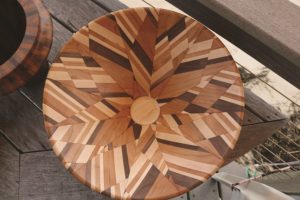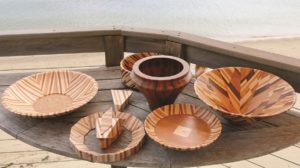I learned the basics of turned wood bowls in junior high school wood shop, and the challenge of it has fascinated me ever since. But college, then family, and my business occupied most of my time, and it wasn’t until quite a bit later, after my kids were older, that I returned to woodworking.

On a first foray back into it, I found an inexpensive used commercial wood lathe. The thing was a beast and I had some fun with it. But turning bowls out of solid stock usually means leaving most of the material on the floor by the time the project is done. Being a little bothered by the waste, I decided that, if I was going to continue to develop the craft, I wanted to figure out a more efficient way with these precious materials.
As an architect and geometry nerd, I knew there must be a way to construct a shape, sort of a truncated prismatic cone, that would approximate a form I could then turn without wasting too much wood.
I let my architecture and real estate development work fill my days. But I kept formulating ideas in my head.
Our move to the Cape helped me get to the bowl turning I now do.
Having vacationed here for many years, I came upon an opportunity to develop a property in Truro. We ended up with an affordable vacation home, and from there I persuaded my wife to take a few months off of work and join me for a longer stretch. We never left. I became involved in the community as building commissioner in Truro and Provincetown, and joined the Outer Cape Chorale.
When I signed up for an evening wood turning class with Nauset Community Education, I started thinking about my little construction problem again and learned there is a technique called segmented turning — exactly what I was looking to do. In segmented turning, the workpiece is composed of multiple pieces that are glued together, leading to countless ways to construct pieces to then turn. The shapes and designs that emerged captivated me.

I’m an inveterate doodler. I keep a sketchbook with ideas and calculations that will bring my vision to three-dimensional form. My design process can be intuitive and random, but I’m always thinking about geometry. I use a lot of cast-off and found hardwoods — it could be scrap flooring, or pieces that commercial millworks toss, or even old butcher-block countertops. I often let the size, color, and species of the wood suggest patterns and form. Sometimes they can be symmetrical, sometimes random and abstract. They are almost always round.
Each piece consists of multiple layers that I cut and glue together. Then I turn and reglue. There’s a lot of planning involved to achieve the desired shape, but there’s also an outcome you cannot exactly anticipate, which is what the pattern will look like when it’s all put together. I am allowing that randomness to happen.
Wood turning is a craft where the education on materials and design is never-ending. It’s a good thing we ended up here on the Outer Cape, where it doesn’t take a whole lot of urging to be creative — I still have much to learn.



